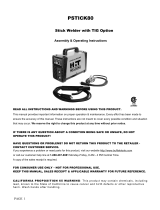Page is loading ...

Electrical Markets
Electrical ame barrier and thermal management
insulation application guide for LED luminaires
Eective ame
barrier technology
for ecient
integrated LED
luminaire designs.

Introduction
This application guide
describes how electrical-
grade ame barrier products
can be used in integrated
LED (Light Emitting Diode)
light modules, based on
work with a world-class
LED manufacturer.

Background
The $100 billion global lighting industry is being transformed by the
technical breakthroughs in Light-Emitting Diodes (LEDs). The main drivers
of visible light from electricity), longer life, increased functionality and
shrinking price. It has been observed that every 10 years, the cost per lumen
(unit of useful light emitted) falls by a factor of 10, and the amount of light
generated per LED package increases by a factor of 20. (This relationship
is called Haitz’s law, which is analogous to Moore’s law describing the
number of transistors on an integrated circuit over time.)
Architectural lighting manufacturers are the early LED adopters, but other
lighting applications are emerging. LED light manufacturers are going
™
Flame Barrier FRB
lighting applications.
LED technology is expected to gain a larger share
of lighting, as result of anticipated performance
and cost improvements.

According to a major
research rm, the
technology mix in
the global lighting
market is expected
to increase from just
over 10% in 2013 to
more than 60%
in 2020.
1.E+04
1.E+03
1.E+02
1.E+01
1.E+00
1.E-01
1.E-02
1.E-03
1.E-04
lm & $/lm
Cost/Lumen Flux/Package
Red
White
+20x/Decade -10x/Decade
1965 1970 1975 1980 1985 1990 1995 2000 2005 2010 2015 2020
Haitz’s Law (2010)
Source: U.S. Dept. of Energy
Thermal Management
Relative Power Conversion for “White” Light Sources
Incandescent†
(60x)
Fluorescent†
(Typical linear CW) Metal Halide‡ LED*
Visible Light 8% 21% 27%
IR 17% ~ 0%
UV 0% 0% 19% 0%
Total Radiant
Energy
81% 58%
Heat (conduction
+ convection)
19% 42% 70-80%
Total 100% 100% 100% 100%
†IESNA Handbook ‡OSRAM SYLVANIA
Source: U.S. Dept. of Energy
(http://apps1.eere.energy.gov/buildings/publications/pdfs/ssl/thermal_mgt_white_leds.pdf)
Ecient Integrated LED Luminaire Design
LED technology with its unique characteristics requires special design

The heat sink can be incorporated
thermal pad helps conduct the
heat from PC board to the housing.
Direct connected (UL 8750 Class
1 luminaires require UL94 5VA
rated housing materials to safely
contain these higher voltages.
Creating a 5VA enclosure with
5VA primary lenses eliminates the
optics that would otherwise reduce
the sealing and assembly of the
luminaire. This concept can be
made into a modular design with
common footprint to give designers
incorporating in other similar
Electrical Flame Barrier Requirements
Emitting Diode (LED) Equipment for Use in Lighting Products” with supporting
UL 746 standards for “Polymeric Materials.” Some of the key polymer enclosure
barrier must be a material that can easily be die-cut with holes for LEDs. Good
dimensional stability is also needed for assembly and long-term reliability.

Important Notice
Before using this product, you must evaluate it and determine if it is suitable for your intended application. You assume all risks and liability associated
with such use.
Warranty; Limited Remedy; Limited Liability.
This product will be free from defects in material and manufacture at time of manufacture. 3M MAKES NO OTHER WARRANTIES INCLUDING, BUT
NOT LIMITED TO, ANY IMPLIED WARRANTY OF MERCHANTABILITY OR FITNESS FOR A PARTICULAR PURPOSE. If this product is defective
Electrical Markets Division
6801 River Place Blvd.
Austin, TX 78726-9000 USA
All rights reserved.
Property Typical Results
V-0 & 5VA
High Voltage Arc Tracking Rate (HVTR) 0
0
Hot Wire Ignition (HWI) 4*
High Current Arc to Ignition (HAI) 2
Glow Wire Ignition Temperature (GWIT) 990°C
960°C
High Volt, Low Current Arc Resistance 4
Thermal & Moisture Stability
* Materials that do not comply with the minimum hot-wire ignition levels may be evaluated by
an abnormal overload test or the glow-wire end-product test, per UL 746C
3M
™
Flame Barrier FRB Series Products
™
applications. This series of products is intended for applications as either
enclosure for electrical equipment. The target barrier applications include:
general purpose lighting luminaires (including LED type), electric and
electric hybrid vehicles (e.g. between batteries, battery charger, power
converter, etc.), appliances (e.g. vacuum cleaner, slow cooker, rice cooker,
etc.) and electrical devices (e.g. timers, actuators, switches, etc.). The
convertibility to safely contain electrical hazards.
FRB series products are available in three colors: beige/white marbled,
to minimize light pollution.
Conclusion
LED technology is transforming
the lighting industry with its
lower costs. Integrated direct
connected LED luminaire
designs are the best way to
Series products can and have
been successfully deployed into
these integrated LED luminaire
designs.
/


